John Heginbotham and Maira Kalman premiere a collaboration at Jacob’s Pillow.
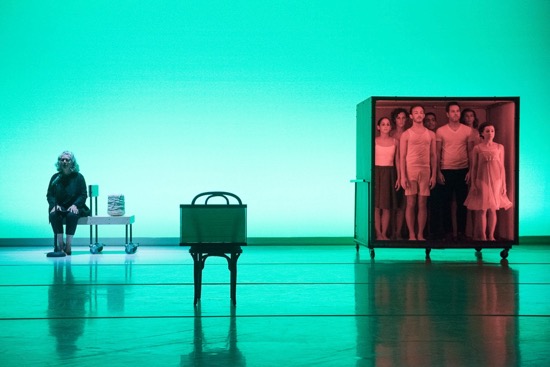
John Heginbotham and Maira Kalman’s The Principles of Uncertainty, Maira Kalman at left. Boxed (L to R): Courtney Lopes, Amber Star Merkens, Weaver Rhodes, John Eirich, Daniel Pettrow, Lindsey Jones, and Macy Sullivan.Photo: Christopher Duggan, courtesy of Jacob’s Pillow
Do I see an acknowledgement or a warning? My destiny maybe? The seats in Jacob’s Pillow’s Doris Duke Studio Theater haven’t paid much attention to me until now, when I’m about to sit in one to watch the world premiere of The Principles of Uncertainty by choreographer-director John Heginbotham and writer-illustrator-guest artist Maira Kalman. The backs of these chairs have been slipcovered and individually labeled. Mine says “Press (ure);” the back of the one in front of me says “complain.” Right. Fortunately, there’s nothing to complain about in this very smart, bustling, charmingly eccentric work. Anyway, the labels that might apply to my husband, who’s sitting beside me, make me think I have nothing to worry about. Would you try to put “radish” and “tisane” together? You wouldn’t.
I have leafed through Kalman’s book (also titled The Principles of Uncertainty), on display in the Pillow’s Archive, and bought one in the on-site store as a birthday present for someone. The wonderful paintings and photographs in it rarely appear during the Heginbotham-Kalman performance, although her chalked words and drawings occasionally dance around on the backdrop.
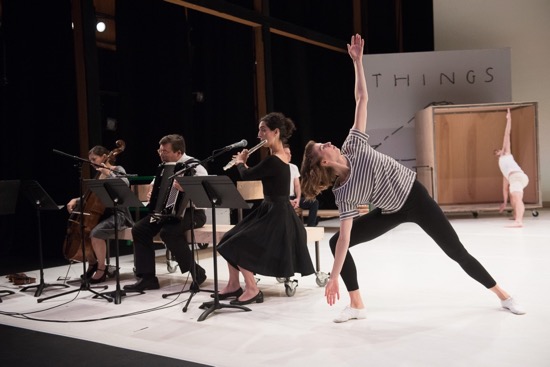
Members of The Knights (L to R): Caitlin Sullivan, Nathan Coci, and Alex Sopp (Colin Jacobsen out of frame at left). Foreground: Lindsey Jones. At back: Weaver Rhodes. Photo: Christopher Duggan, courtesy of Jacob’s Pillow
I can’t quite explain how a dance theater work so neatly crafted can seem so freewheeling and wildly imaginative. Speaking of wheels, there are a number of very serious ones to look at. They make it possible for several different-sized platforms to be wheeled around and caused to disappear. Wave goodbye to the marvelous musicians from The Knights (Colin Jacobsen, director and violin; Nathan Coci, accordion; Alex Sopp, flute plus vocals in three languages (!); and Caitlin Sullvan, cello). Bet you thought they couldn’t be moved. The set also includes a tall bookcase behind whose empty shelves a video shows a major volcano spewing its flaming lava. Kalman says, perhaps apropos of that: “Pompei, 79 A.D. Chance of snow.”
There’s a lot to look at, laugh at, take in, ponder. Somehow in the course of guest artist Daniel Pettrow’s naming of famous dead people and their possible connections, Kafka is envisioned as a waiter whose customer could be Fred Astaire. Mysteries crop up too. That very big framed painting lying on the floor (sleeping maybe?), what is the significance of that? We get to see it briefly as it’s being carted away: a woman in a monstrously full black gown sitting on a sofa. She looks vaguely familiar, but maybe she isn’t.
Musical riches abound. The Knights offer up these composers: Andrea Guerra, Johann Sebastian Bach, Gabriel Fauré, Colin Jacobsen, Heinrich Ignaz Franz von Biber, Heitor Villa-lobos, Franz P. Schubert, J. Leubrie Hll, José Alfredo Jiménez, Ludwig van Beethoven, and anonymous Hungarians. I can almost imagine the composers lying side-by-side or stacked in bunks for a sleepover; they take turns entertaining one another.
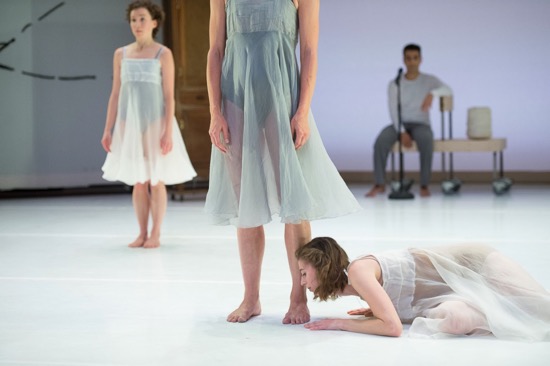
Principles of Uncertainty. (L to R): Macy Sullivan, Amber Star Merkens, and Lindsey Jones (out of frame at R: Weaver Rhodes copying Jones). At back: Daniel Pettrow. Photo: Christopher Duggan, courtesy of Jacob’s Pillow
The dancing is vivid and spirited and expert. Here are some more names: John Eirich, Lindsey Jones, Courtney Lopes, Amber Star Merkens, Weaver Rhodes, Macy Sullivan. They come in several sizes. We get chances to focus on each one of them—long-limbed Jones finishing a solo and standing on one leg to rotate smoothly with the help of her friends; Sullivan, hands clasped, poking out her elbows and shaking them from side to side in response to the tango that Coci’s accordion affirms; Eirich leaping in circles around whatever else is happening. We can also wonder why Jones wants to lay her head on Merkens’s foot, while Rhodes is laying his head on nothing, and Sullivan has no head on her foot. Some quartet!
Movements get transferred, traded, sent home, and reintroduced. Heginbotham may deploy his cast members in contrapuntal trios, intersect them intriguingly, pair them up. His extremely musical choreography keeps their feet busy, and they’re often skimming the ground in low skips, leaps, jumps from two feet to one or from one to two. He’s also adept at shaping a dancer’s body in space; the performers make you aware of their three-dimensionality—not just by how they twist, dip down, turn, or fall, but how they focus. They seem to see what surrounds them as they dance—that spot on the floor that beam of light, that person following behind. . . .
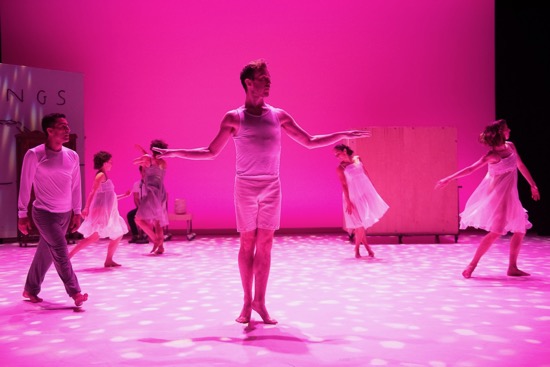
John Heginbotham and Maira Kalman’s The Principles of Uncertainty. Center: Weaver Rhodes channeling. . .(?) At back (L to R): John Eirich. Macy Sullivan, Amber Star Merkens, Courtney Lopes, and Lindsey Jones. Photo: Christopher Duggan, courtesy of Jacob’s Pillow
In this changeable climate, Nicole Pearce’s lighting is not timid. The whole stage may suddenly turn pink or blue or some other hue. (Is it coincidental that, as the lights are dimming at the end of The Principles of Uncertainty, Pettrow is informing Kalman of the colors found in Madame Bovary?) Kalman designed the costumes, with associate Maile Okamura, and they don’t stay the same either. The variegated, not fancy outfits that the dancers wear at the beginning are altered bit by bit. Merkens sheds her yellow sweater early on to reveal a floaty, fog-colored dress, and by the end of the evening, all the women are wearing dresses like that.
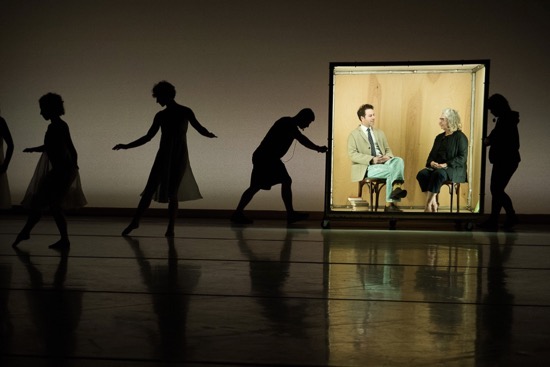
Wheeled away: Daniel Pettrow and Maira Kalman. Silhouetted (L to R): Macy Sullivan, Amber Star Merkens, and crew. Christopher Duggan, courtesy of Jacob’s Pillow
In the final section of the piece, Pettrow and Kalman, a modest, quizzical presence onstage, sit on chairs in a large open box set on end; he reads to her from her own writings, while the box gets pushed around the black-box performing area, coming extremely close to the front row. It takes a while for me to notice that the valiant, black-clad stage crew members have gotten everything not human out of sight.
Heginbotham and Kalman have known each other for some time. She designed Mark Morris’s Four Saints in Three Acts, back when he was a member of Morris’s company, and they have had other artistic connections as well. In her program note, Kalman says that in dreaming up this lovably eccentric work, the two of them took a lot of walks together and noticed things. I can believe it. Here’s how she describes the time they’ve spent puzzling over artistic choices:
“John and I are trying to make something that feels like it is almost nothing.
Well not nothing, of course, but the kind of nothing that is full of the sad sweet funny uncertain life we lead.”
That is definitely something.
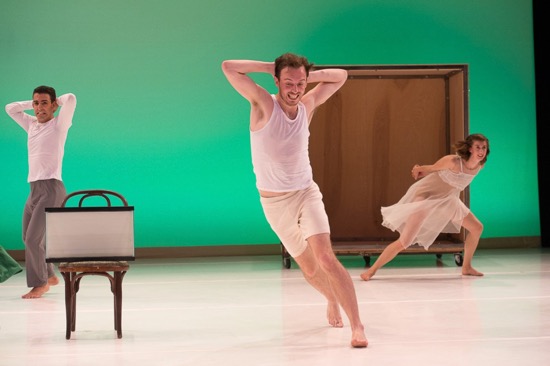
John Heginbotham and Maira Kalman’s The Principles of Uncertainty. (L to R): John Eirich, Weaver Rhodes, and Lindsey Jones. Photo: Christopher Duggan, courtesy of Jacob’s Pillow.

Wonderful appreciation of what I think is a stunning work. On Thursday night, I happened to be in the same seat! (Or did I just happen to get the same slipcover?) It reads, in its entirety, “The/PRESS/(ure)/is/GREAT”–so I guessed it might have been assigned me as a press seat–how nice to have that compliment (if you take out the parenthesis). But who is under press(ure), the performers, or the press trying to say something coherent about the piece? One of the Principles of Uncertainty, I guess. The large painting is a repro of Manet’s Lady with a Fan (the model is Jeanne Duval, Baudelaire’s mistress), which I have never seen because it’s in Budapest–but here it is. That might very well go as well with the recitation of colors from Madame Bovary. Heginbotham is remarkable. He makes work that looks intuitive, yet is beautifully crafted, as though all the dancing just popped out of his head like Athena. I get such pleasure watching his dancers that although I can’t anticipate what’s coming next, it always feels as though I get just what I hoped for. Lindsey Jones is marvelous, and Heginbotham draws out her sneaky, quirky humor, which I don’t really recall from her performances with Pam Tanowitz. And what a delight to see Amber Star Merkins back in an important dance work & looking statuesque & terrific. But they all are wonderful, & Principles is a wonder. I think Heginbotham is making some of the most exciting work around.